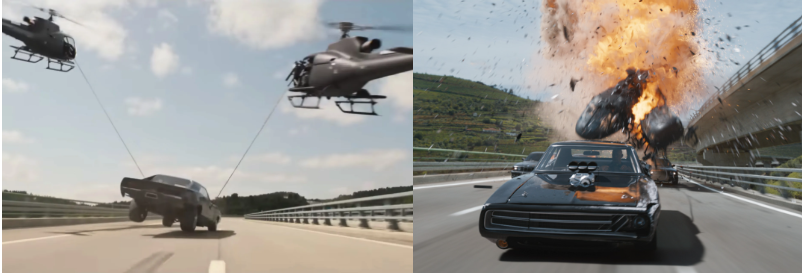Assignment #3:
Fast and Furious 10: Hollywood action films
Ricardo Alexander Munoz Cazares
VISA1500_01 – Introduction to Visual Culture
Professor Atkins
March 31, 2025
The film is packed with scenes of speed, action, and danger, featuring nearly impossible and risky maneuvers. In the first image, an intense and dynamic scene is created. This is an action shot from behind the scenes with helicopters in pursuit, capturing the resulting chaos on the same stretch of highway. Toretto’s character is often depicted as someone who faces danger head-on, and this scene reflects his fearless nature and the chaotic world he navigates. The car appears to be tethered by cables to the helicopters to control its movement. Seeing this shot from behind allows the viewer to feel part of the action and gives an unrealistic sensation that the car is about to fly. The scene is filled with visually exciting content that likely generates adrenaline in the audience and fans of this saga.
The second scene , we witness an adrenaline-charged chase of a black vehicle—Dom Toretto’s legendary Dodge car—swerving away from a massive explosion on a speeding highway.The scene is a front shot. This perspective can really emphasize the intensity and chaos of the action, making the viewer feel like they’re right in the middle of it. It’s a chase, and a collision involving large helicopters generates an explosion, causing debris to fly through the sky. Meanwhile, two other vehicles are at risk of being engulfed in the explosion’s fire. The scene is enveloped in a sense of complete chaos, characteristic of the explosive, high-speed action that has made the Fast & Furious series one of the biggest-grossing franchises in history (Gulam et al., 2023).
The following elements are involved in these scenes. First, the environment in which the scene is set is a risky high-speed chase where two helicopters are used to stop the black and powerful car. Dom Toretto is determined to reach the person who has captured his son. Moreover, the explosion takes place near a bridge. If the key structural points collapse while Dom is driving underneath, he would need to either change lanes or accelerate to maintain control of his vehicle. A massive explosion occurs after his black Dodge car is freed and continues the chase on the highway. The burning glow of the explosion reflects off the metallic shine of the car as flames advance like a wave (Gulam et al., 2023).
The essential elements that create chaos in the scenes are cars and helicopters. The bad guys succeed in commandeering the helicopters, allowing them to potentially shoot at the car or use a cable to strand it. Cars are also central symbols, its fast and powerful, (Newland, 2009) stands that cars are symbols of masculinity and power, representing freedom, success, and mobility.
Additionally, suicidal aerial stunts may be employed to block Dom’s escape route, making his getaway even more challenging. Behind him, to the left, a column of armored vehicles desperately tries to seal off his retreat, while overhead, enemy helicopters looms threateningly. Furthermore, if the explosion hits enemy vehicles, they can lose control and collide with one another, effectively blocking the road. This would force Dom to take a riskier, alternative route, where success or death are the only outcomes. Finally, the shockwave from the blast creates such powerful chaos that it could cause the car to go out of control if Dom weren’t driving. Helicopters crash into a retaining wall, and other vehicles in the radius are knocked out of control, spinning wildly into each other, allowing Dom to continue the chase.
Characters who live on the edge, facing constant threats and uncertainties, are often symbolized by the destruction of their cars. This destruction highlights the fragility of their existence and the ever-present danger that their structured lives can be disrupted at any moment, emphasizing the instability and vulnerabilities inherent in modern life (Newland, 2009).
Car destruction scenes can also symbolize broader societal vulnerabilities (Newland, 2009). For instance, some scenes depict steel parts flying and turning into lethal projectiles, with the possibility that these objects could crash into Dom’s car. Similarly, modern society faces many disruptive situations, particularly affecting marginalized and vulnerable communities, who are often the most impacted by social and economic challenges. Society can be significantly affected if a balance is not found between these groups.
The movie features a multicultural cast with characters from various ethnic backgrounds. Most of the characters are men who experience an intense mix of action and exaggerated violence, setting high and unrealistic expectations for their male fans, thereby reinforcing masculine stereotypes. Gender representation in action films often perpetuates traditional stereotypes, although it can also offer opportunities for subversion and empowerment of female characters (Alonso Villa, 2023). Despite the presence of independent, intelligent, and capable female characters, such as a skilled pilot and fighter, they are often appear as supporting characters lacking depth and relevance in the story. This highlights the persistence of gender stereotypes: masculinity is associated with strength and power, while femininity is confined to romantic relationships and intellectual capabilities, but not to leading roles.
The Art of Fast Editing in Fast & Furious
The scenes described are part of the action-packed sequences in Fast & Furious X, where Dominic Toretto tries to save his son while chasing over a bridge. Numerous edit cuts can be found throughout these scenes. In just one minute of action, there are 30-60 visible edits, meaning the film rapidly switches between shots and viewpoints. This fast-paced editing is crucial as it heightens the tension and makes the viewer feel the speed and danger at every moment. The film constantly changes perspective, immersing the viewer in the action.
Different types of shots are used to show various angles and perspectives, enhancing the audience’s experience and showcasing the spectacular effects of explosions. These varied shots and rapid editing techniques contribute to the intense and immersive experience that fans of the Fast & Furious saga have come to love.
Here are some examples:
First-Person Shots: Taken from inside Dom’s car, these shots reveal what he sees while driving. This places the viewer in Dom’s shoes, feeling the danger, rapid movement, and tense decisions he has to make.
Third-Person Shots: These shots show Dom’s car from different angles as he avoids obstacles, exploding cars, and stalking helicopters. This type of shot provides a broader scope of the chase.
Aerial Shots: The camera rises to show the chaos on the bridge, allowing viewers to observe the surroundings and the disorderly scene.
Close-Ups: The camera gets very close to Dominic’s face, detailing his tension, focus, and unease. These close-ups heighten the emotional impact, conveying what the character is thinking.
The camera movement in the sequence is smooth and dynamic, closely following the actions of the cars. However, there are moments when the camera becomes shaky, especially during chaotic scenes, such as when helicopters are shooting. This effect is likely achieved with handheld cameras, adding a sense of urgency and chaos. The viewer can discern that continuous cuts are being made between different shots, but these cuts are not distracting. Instead, they are used to build tension, ensuring the audience never loses track of the action and remains focused on the unfolding events.
This editing and camera technique is crucial to conveying the film’s themes of speed, risk, and emotion. The rapid pace of editing and camera shifts immerses the audience in the scene, making them feel the same level of urgency and adrenaline as the characters. Without these techniques, the scene would lack the necessary urgency and intensity, which is why it needs to be so emotionally charged.
The Fast and Furious saga has consistently captivated audiences over the years, with each release drawing millions of viewers. While not all films in the series have broken records, “Furious 7” stands out as the highest-grossing film, reaching the $1.5 billion mark and boasting the strongest opening weekend (Box Office Mojo 2025). Both “F9” and “Fast X” had lower lifetime grosses compared to their predecessors, which could be attributed to various factors. However, it is clear that the franchise transcends on-screen thrills, achieving success and maintaining a strong fan base.
In today’s competitive market, it is not easy for a franchise to sustain popularity and profitability. Nevertheless, the Fast and Furious series has proven its worldwide appeal, making it one of the most commercially successful action franchises in modern cinema.
References
Alonso Villa, Cristina. (2023) “Gender Representation in Contemporary Action Films: Stereotypes and Empowerment Opportunities.” Journal of Gender Studies, 12 (3).
Box Office Mojo. “Fast & Furious Franchise.” Accessed March 30, 2025. https://www.boxofficemojo.com/franchise/fr3628568325/.
Gulam, J., Feinstein, S., & Elliott, F. (2023). Full-Throttle franchise. Gulam, Joshua – Feinstein, Sarah – Elliott, Fraser – Bloomsbury Publishing – Torrossa. https://www.torrossa.com/en/resources/an/5397259#page=70
Newland, P. (2009). Look beyond the violence: car destruction in American films. European Journal of American Culture, 28(1), 5–20. https://doi.org/10.1386/ejac.28.1.5_1


Jacinta Mugo
With a particular emphasis on the portrayal of masculinity, the function of vehicles, and gender relations, the study of Fast & Furious X provides a good summary of the action-packed scenes and thematic foundations of the movie. Though the author skilfully draws attention to important elements including the fast-paced editing, exciting action sequences, and societal symbolism, a more thorough examination of the academic sources used would enhance the debate.
Although Alonso Villa’s (2023) and Newland’s (2009) works are mentioned in passing throughout the essay, their ideas seem to be misused. For example, by clearly linking these sources to the examination of Dom Toretto’s character and the franchise’s representation of male identity, the conversation on masculinity may have been expanded. Similarly, more examination of Newland’s work on the frailty of contemporary existence would bolster the case for the societal vulnerabilities represented by automobile destruction.
Regarding the image cited in the essay, it is challenging to evaluate its correctness in the absence of a visual reference. Nonetheless, given the thorough explanation of the action sequences, the picture would probably be a good depiction of the tumultuous, fast-paced moments that were recounted.
Although the analysis offers a solid basis overall, it might profit from a more comprehensive integration of academic research and a more in-depth examination of the movie’s thematic issues.